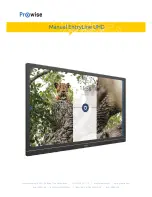
68
2. Enter the path to the *.BMP in the
Bitmap file
field
or click the
Browse…
button to select it with the
familiar file selection dialog.
The title of the frame shows the State of the bitmap
being imported. A preview of the bitmap is displayed
in the frame. The preview is sized to fit in the area of
the dialog. This may distort the bitmap image.
Note:
When the bitmap is placed on the screen,
it is sized to the proper proportions.
Information about the bitmap is displayed along the
left side of the dialog.
Note:
Width and Height values are in pixels.
3. One color of the bitmap can be selected as
transparent. This is useful for eliminating
background colors.
To make a color transparent simply select the
Transparent
check mark and then click anywhere
in the area to be made transparent. In the
example, white is selected as the transparent color.
Note:
The transparent fields cannot be filled in manually.
4. Click on
Next
and continue to import bitmaps until the specified State numbers are populated. The graphic importer
guides you through each state to get and install BMP graphics. The Back button can be used to review the entered bitmaps.
5. Click
on
Finished
when final selection is
made.
7.6.3.5 Editing an Existing Bitmap
First,
Export
all of the bitmaps for all states of the cell to be edited to a directory.
Next, the bitmaps are then edited using a bitmap editing utility such as “MSPaint®”.
Then, the cell being edited must then be deleted from the bitmap library.
Note:
The
Delete
bitmap
operation deletes all bitmaps in a cell. There is no undo for this operation.
Finally, the modified bitmaps are then added back into the cell in State order sequence.
Note:
There is no provision for editing or deleting only one state of a cell that has multiple states.
New library with example bitmap in cell 0
Summary of Contents for MMI-1500
Page 2: ...ii...







































